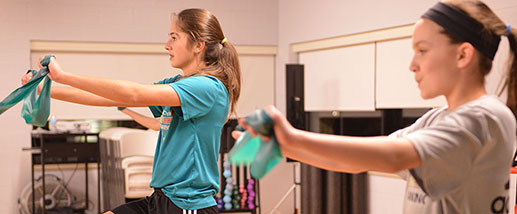“This wasn’t my first rodeo,” said Mark Gillard, a 65-year-old husband, father and grandfather speaking about his most recent episode with health care. “Several years ago I had a ruptured appendix but waited three days to seek medical care. I learned a lot from that,” said this physically active senior, who watches his diet and also meditates.
On Sunday, May 20, 2018, Mark was doing leg extensions at home on his universal weight machine when he felt sudden pain in his right foot.
“It felt like I had broken a bone at the top of my right foot,” he said. “I took my shoe off and from the ankle down, my foot was white.”
Thanks to Mark’s quick action and the expert medical care he received at Mercy Health, Mark is still able to pursue his passions of spending time with family, working out and participating in long-distance recumbent bike rides.
Mark and his wife quickly drove to Mercy Health Urgent Care on the East Beltline. “They knew immediately what was wrong and told me to go to the ER right away and not to stop anywhere first,” he recalled.
Providers in Mercy Health Saint Mary’s ED ordered a CT scan and confirmed what they already suspected: There was no blood flow going into Mark’s right foot. The scan also revealed that Mark had 30 mm (very large) popliteal artery aneurysms behind each knee that would require surgical intervention. Popliteal artery aneurysms can form blood clots that travel down the leg, and the aneurysm in Mark’s right leg had thrown several blood clots to his foot.
In this case, Mark’s condition was hereditary, and the team suspected that the aneurysm behind Mark’s right knee had been throwing clots for years. It was the latest clot that had closed off all blood supply to his foot.
The first priority was to clear the clot in Mark’s foot, which Mercy Health Physician Partners (MHPP) vascular surgeon Michelle Kosovec, MD, hoped she could accomplish using a clot-dissolving medication administered through a catheter in a minimally invasive procedure. The medication is the same drug used to dissolve a stroke, and it must be monitored closely.
On Monday, Dr. Kosovec performed an angiogram during which she inserted a catheter into an artery in Mark’s leg and administered the medicine to begin dissolving the clot.
The following day, her partner, MHPP vascular surgeon Joshua Greenberg, MD, re-examined the foot to see if the clot had dissolved. Nothing had changed, and so the only option was to give the medication more time to work.
At this point, Mark’s foot remained white, but his toes were turning black and blue. Mark and his family were told that with no improvement, he could be facing a right leg amputation.
Despite this grim news, Mark maintained a positive attitude. “I never once thought I was going to lose my leg. I always look positively at stuff. It’s all in the way you look at things. If I had to lose my leg, I’d adapt to it and make the changes. I told myself, ‘There are a lot of worse things than this,’ he shared.
Throughout Tuesday night, Mark’s nurse continued to check for a pulse in Mark’s right foot. Around 2:30 a.m. on Wednesday morning, she started hearing blood flow. “I could feel the blood starting to go back into my foot,” which he described as painful.
 This good news led to Dr. Kosovec being able to restore blood flow and discontinue the clot-dissolving medication later that day. On Friday, Dr. Kosovec harvested a vein from Mark’s leg and performed a bypass around the aneurysm behind his knee, which protected him from future blood clots in that leg. The aneurysm behind Mark’s left knee was fixed in another bypass surgery in August 2018.
This good news led to Dr. Kosovec being able to restore blood flow and discontinue the clot-dissolving medication later that day. On Friday, Dr. Kosovec harvested a vein from Mark’s leg and performed a bypass around the aneurysm behind his knee, which protected him from future blood clots in that leg. The aneurysm behind Mark’s left knee was fixed in another bypass surgery in August 2018.
With the success of the first bypass, Dr. Kosovec believed there was a good chance that Mark could save his foot, but nothing was certain.
The next immediate concern was about saving Mark’s toes. Mark was then introduced to the newest member of his care team, John Morris, DO.
“Dr. Morris was in charge of my toes,” said Mark, referring to treatment in a hyperbaric chamber at Mercy Health Wound Care.
A former diving enthusiast, Mark described his experience this way: “I did 22 ‘dives’ in that chamber, and the treatment worked. My toes regenerated their skin, and today I have all of my toes!”
During his “many hours of contemplation” as he lay completely still in his hospital bed, Mark was grateful that he had come to Mercy Health for care. He considers himself extremely lucky.
“I truly believe that if I had been anywhere else, they’d have immediately amputated. Mercy Health gave me enough time for the blood to return to my foot; they didn’t give up on me. As long as the tests came back saying I was tolerating the medicine, they allowed me to stay on it long enough for it to work. Anywhere else, I don’t think they would have done that, since I was on it for about 72 hours.
Today, Mike says he has nearly fully recovered. In December 2018, before the weather changed, he did a 30-mile bike ride and had no trouble at all. His praise for his entire care team summarizes his experience at Mercy Health:
“The whole package at Mercy Health is good — the doctors and the nurses. They communicate so well together. I feel very fortunate to have had the surgical team I had. Doctors Kosovec, Greenberg and Morris work as a team. They were professional, and they respect each other’s abilities.
“I cannot tell you how much I appreciate nurses at Mercy Health. I have nothing to say but good things about them, especially their bedside manner. They are so professional, respectful and compassionate. Except for losing my summer, I would say this was a good experience, especially watching all of these people do their jobs.”




